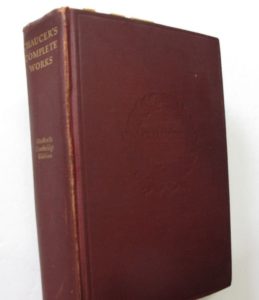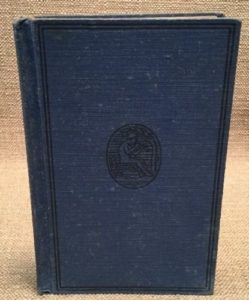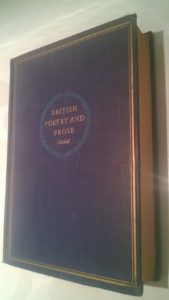I’ve just had a particularly interesting email exchange with Paul Relkin concerning the Feynman Challenge Ciphers, which he has generously allowed me to share here. The context is that the first Feynman Challenge cipher’s plaintext was from the very start of Geoffrey Chaucer’s Canterbury Tales, i.e. the first twelve lines of the General Prologue:
WHAN THAT APRILLE WITH HIS SHOURES SOOTE
THE DROGHTE OF MARCH HATH PERCED TO THE ROOTE
AND BATHED EVERY VEYNE IN SWICH LICOUR
OF WHICH VERTU ENGENDRED IS THE FLOUR
WHAN ZEPHIRUS EEK WITH HIS SWEETE BREFTH
INSPIRED HATH IN EVERY HOLT AND HEETH
THE TENDRE CROPPES AND THE YONGE SONNE
HATH IN THE RAM HIS HALVE COURS Y-RONNE
AND SMALE FOWELES MAKEN MELODYE
THAT SLEPEN AL THE NYGHT WITH OPEN YE
SO PRIKETH HEM NATURE IN HIR CORAGES
THANNE LONGEN FOLK TO GO ON ON PILGRIM[AGES]
Paul writes:
The Prologue
I’d like to share with you a possible clue I’ve discovered to the sources of the 2nd and 3rd Feynman Ciphers. My findings relate to the identification of a specific published transcription of the Canterbury Tales that is the probable source of the 1st Feynman Cipher.
As you are probably aware, the Canterbury Tales have been transcribed and reprinted innumerable times. Among the many different published editions of the Canterbury Tales, there are several idiosyncratic spellings associated with particular transcriptions. Although individual lines are spelled the same way in many different editions, I found that the 12 lines of the Feynman Cipher taken together are unique enough to match only one published transcription, like a “word fingerprint”.
To find the edition that the Feynman Cipher is based on, I extensively searched for editions of the General Prologue that were published before or during World War II and compared the word spellings to the Feynman Cipher.
First, I discovered what may be a typo in the 1st Feynman Cipher. The word “brefth” does not appear in any published edition of the General Prologue I have been able to identify. The most likely correct spelling is “breeth”.
Second, I found that the only version of the General Prologue that matches the Feynman Cipher is Fred Norris Robinson’s 1st edition of Chaucer’s Complete Works. In the introduction to his book, Robinson actually discusses several of the uniquely spelled words that later found their way into the 1st Feynman Cipher and explains why he rejected the popular spellings and chose less common ones.
Possible Sources
Having identified Robinson’s transcription as the probable source of the 1st Feynman Cipher, I discovered that there are only a few different editions of this transcription that were published between 1933 and 1938 that could have been used by the author of the Feynman Ciphers:
In 1933, Houghton Mifflin published this book in at least three editions:
The Complete Works of Geoffrey Chaucer (black):
The Complete Works of Geoffrey Chaucer, Student’s Cambridge Edition (red):
The Poetical Works of Chaucer, Cambridge Edition (white):
In 1936, Houghton Mifflin published small books containing parts of Robinson’s Canterbury Tales with an introduction written by Max John Herzberg. The title of the book that contains the quote used in the cipher is “The Prologue, the Knight’s Tale, and the Nun’s Priest’s Tale”:
In 1938, Houghton Mifflin included Robinson’s Canterbury Tales in a two volume collection of British poetry by Paul Robert Lieder called “British Poetry and Prose” (Volume 1):
Interestingly, Robinson’s 2nd edition of Chaucer’s Complete Works in 1957 no longer matches the spellings in the cipher!
It’s specifically here where I think we may find clues to the 2nd and 3rd ciphers. It seems plausible to me that “British Poetry and Prose” contains other literary works that were the basis for the 2nd and 3rd Feynman Ciphers. For example, several of its poems have 6 letter words that repeat twice, consistent with “CJUMVRCJUMVR” in the 2nd Feynman Cipher.
Robinson’s 1933 book of Chaucer’s Complete Works could also be the source of the 2nd and 3rd ciphers. The 1933 book is part of a series of books called “The Cambridge Poets” and the 1936 book is part of a series called “The Riverside Literature Series”. The other books in the series are also potentially worth looking at.
Los Alamos?
My research suggests that several copies of these books have the original owner’s name and other notes written in them. If we were able to locate the copy that was used at Los Alamos, it might reveal the name of the scientist who created the ciphers. There may be other writings within it that would give further clues about the ciphers.
I discovered that the Mesa Public Library in Los Alamos has a copy of Robinson’s 1933 book. The Mesa Public Library originated during World War II in the Big House where Feynman lived, so I wondered whether the library book could be the copy that was used to create the cipher.
So, I recently arranged to borrow that book through interlibrary loan. Since I live on the East Coast, I had to try 5 different libraries before I found one that would let me request that particular book. It then took two tries because they accidentally requested the book from the Mesa Public Library in Arizona instead of the one in New Mexico. I finally received the book I requested. Unfortunately, the book plate indicates that it was donated to the library in the 1970s. This makes it unlikely (albeit not impossible) that this was the specific copy used in the period around World War II to create the 1st Feynman Cipher.
I hope you find this information interesting and that it brings us a step closer to solving the 2nd and 3rd Feynman Ciphers.
Chaucer and Cryptography?
(((NickP: I responded here, pointing out:)))
Incidentally, there are two interesting links between Geoffrey Chaucer and cryptography. The first (which you may well have heard of) is that he included six blocks of ciphertext in his Treatise on the “Equatorie” (basically a kind of astrolabe). But the second is that a very major work on Chaucer (finally published in 1940) was written by John Matthews Manly and Edith Rickert, both well-known code-breakers. (I’ve covered them a few times on CM, mainly because of Manly’s links to the Voynich Manuscript.)
However, Rickert died in 1938, Manly died in 1940 and Los Alamos only really started in 1943, so we can rule out a direct transmission from either of them to Feynman. All the same, I do consider it entirely possible that one/both of them was/were the ultimate source of the three cryptograms. Just so you know!
(((To which Paul replied:)))
Concerning your excellent point about Rickert and Manly, there was another colorful link between a Chaucer scholar and Los Alamos that I found while I was researching editions of the Canterbury Tales. John Strong Perry Tatlock was a famous Chaucer expert who transcribed Chaucer’s Complete Works. His daughter, Jean Frances Tatlock, had a romantic relationship with J. Robert Oppenheimer between 1936 and 1939. They continued to have an affair during Oppenheimer’s marriage. Their relationship was used as evidence against Oppenheimer during his security clearance hearings because Tatlock was a member of the Communist Party. As you know, Oppenheimer and Feynman had more than a passing acquaintance – as for Tatlock and Feynman, who knows?





Allowing, actually mandating, that ancient texts, and ciphered texts that were based on it, speak for themselves is a critical first step that amateurs seldom master. As a mitary trained cryptanalyst I was taught to parse Russian and English texts in 1957. Finishing third as a high school graduate, barely beaten to two married college grads, that stayed at the Ft. Devens, Mass school as instructors,
I was later deployed to Beirut, Lebanon in the 1958 crisis and asked to decode Arabic texts, given only an English to Arabic, and Arabic to English dictionary, and offered assistance by Monterey Language school graduate. At the time Chinese Mandarin was the hardest course offered at Monterey, with Arabic being second. Before becoming a cryptanalyst, I had barely passed Monterey’s language test, I think based on Esperanto. My two years of high school Spanish were insufficient to pass the second Monterey entrance test, allowing my two of my three years of US Army enlistment to be spent overseas.
By 2001, I had spent ten years trying to find a door to parse Egyptian math texts that offers over 200 problems that were discussed in a hard to read hieratic arithmetic patterns. Forcusing on the simplest text, 26 lines of the Egyotisn Mathematicsl Leather Roll, found by Henry Rhind in 1858, donated to the British Museun in 1864, and unrolled in 1927, two lines of text reported a scribal student converting 1/8 and 1/16 to out-of-order unit fraction series, that turned out to be both scaled by LCMs 25 and 6, thought of as 25/25 and 6/6.
Please note that 1927 British museum decoding undervalued the text, oddly reporting that only additive patterns were contained therein. It turns out that 1/8 times 25/25 = 25/200 was a quotient with a subtraction that scaled a remainder by 6/6 in a mental form of number theory, not additive in the BM manner, that was a parallel to the AKhmim Wooden Tablet’s five 1900 BCE Hekat scaled by 64/64 and 5/5 that multiplied by 1/3, 1/7, 1/10, 1/11 and 1/13, and proving each two-part answer by mukltiplying by 3, 7, 10, 11, and 13 that exactly returned 64/64, the initial term five terms as Hana Vymazalova published in 2001.
My coauthor Bruce Friedman had added an appendix discussing the AWT, and it’s interesting patterns reported by Georges Daressy in 1906. It took three years for Bruce to find Vymazolva’s and Daressy’s French 1906 papers, and publish in India, since the BM and its friends oddly reported the EMLR arithmetic closed, disallowing European journals to offer a second opinion.
Thanks for discussing the Feynman codes. I know the man for creating the first physics numeration system, based on polar coordinates and magnutudes, ending Einstein’s naive Eucludean geometry model, adjusted by a Lorentz transform to correct for curved space that Einstein called Gaussian space.
Nick, I love your blog. I’ve been reading it on and off for several years now & subscribe to your mail list. You’ve mentioned John Manly several times and (in the way of a shameless plug) I’d like to point you to my book (https://www.amazon.com/Codes-Ciphers-Spies-Military-Intelligence/dp/3319294148/ref=asap_bc?ie=UTF8) on a series of articles that John Manly wrote in 1927 on the experiences of MI-8 during WWI. There are a dozen essays in there that Manly wrote for Colliers Magazine but which were never published. Some of the articles have crypto in them, including Manly and Rickert’s description of the decipherment of the Waberski cipher in 1918. His description differs somewhat from Yardley’s description in American Black Chamber. I also have Manly’s trial transcript from Lothar Witzke’s court martial in August 1918; if you’d like a copy just let me know. Please keep up the great work!
john
Nick or anyone interested in Chaucer – I’ve looked in vain for any mention of those six blocks of enciphered text in the various translations and sources I can find online – zilch, unless it is represented by a short line of stars between sections 43 and 44 in this version:
https://classicalastrologer.com/geoffrey-chaucer-a-treatise-on-the-astrolabe-c-1391/
St John’s College Cambridge has a mss believed to be one of the earliest extant copies of Chaucer’s Treatise on the Astrolabe and has a nice initroduction (and ink to the ms) here
https://www.joh.cam.ac.uk/library/library_exhibitions/schoolresources/astrolabe/chaucer
What I can’t seem to find is any mention of the cipher’s have been deciphered, or what exactly Chaucer thought needed to be enciphered.
Since ciphers aren’t really my thing, I’d rather not have to buy books about it which will occupy space that is in ever-shorter supply
For anyone else who may be interested in the ‘Chaucer cipher’
Sarah Goslee has been incredibly generous and provided the answer to my question and much more.
Here’s some of it..
The Equatorie is now known to have been written by John Westwyk, and
there’s a facsimile of the Peterhouse manuscript at
https://cudl.lib.cam.ac.uk/view/MS-PETERHOUSE-00075-00001/1
The cipher is simple substitution, and the key is given in Derek Price (1953), and elaborated (I think) in his 1955 book, The Equatorie of the Planetis. Cambridge University Press. p. 3.
Eagleton’s paper of 2007 [copy kindly given] says, “The cryptogram in the Equatorie is a simple substitution of symbols for letters which conceals information about the tables that the notes accompany and simplified instructions for using the instrument” but doesn’t provide the actual information.
There’s worked example of breaking part of it here:
https://patcosta.com/wp-content/uploads/2015/09/Blown-to-Bits-Reading-Encryption-.pdf